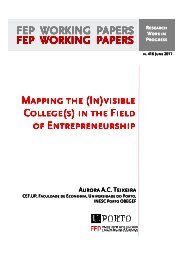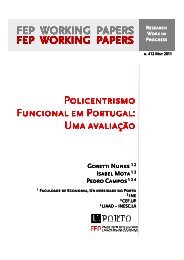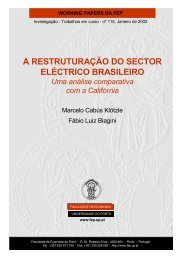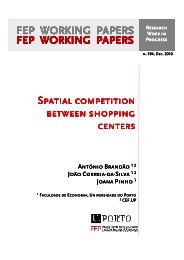Minnesota Satisfaction Questionnaire - FEP - Working Papers
Minnesota Satisfaction Questionnaire - FEP - Working Papers
Minnesota Satisfaction Questionnaire - FEP - Working Papers
Create successful ePaper yourself
Turn your PDF publications into a flip-book with our unique Google optimized e-Paper software.
1996) and all KMO for individual items (measures of sample adequacy) were >0.7,which is well above the acceptable limit of 0,5 (Field, 2009). Bartlett’s test of sphericity 2 (45)=685.67, p< 0.001, indicated that correlations between items were sufficientlylarge for PCA.Table II - Oblimin rotated component matrix based on correlations among the items ofthe MSQ and communalities (h 2 ).Component 1 Component 2 h 2MSQ 19 – The praise I get for doing a good job .81 .21 .71MSQ 3 – The chance to do different things from time to time .78 .14 .62MSQ 10 – The chance to tell people what to do .76 .23 .59MSQ 11 – The chance to do something that makes use of myabilities.75 .18 .64MSQ 16 – The chance to try my own methods of doing the job. .72 .16 .55MSQ 15 – The freedom to use my own judgment .70 .31 .59MSQ 5 – The way my boss handles his/her workers. .15 .86 .75MSQ 6 – The competence of my supervisor in making decisions .21 .81 .70MSQ 2 – The chance to work alone on the job .32 .66 .53MSQ 4 – The chance to be “somebody” in the community .14 .65 .44% of Variance accounted for 46,62% 14,56%Items 1, 3, 15, 17, 18 and 19 were eliminated from the analysis due to lowcommunalities and items 2, 9 and 14 were dropped due to multiple component loading.Two components had eigenvalues over Kaiser’s criterion of 1 and an analysis of thescree plot indicated the existence of two components as well. Table II shows the factorloadings after the rotation. The items that cluster on the same components suggest thatcomponent 1 represents satisfaction with task enrichment and component 2 satisfactionwith leadership and empowerment.Internal consistency was estimated using Cronbach’s alpha. The two factors that wefound showed a good internal consistency, with alpha values above 0.70 (Nunnally,1978): α =. 87 for factor 1 (satisfaction with task enrichment, 6 items), α =.78 for factor2 (satisfaction with leadership and empowerment, 4 items) and α =.87 for the globalscale.3.2 Confirmatory factor Analysis3.2.1 Previous Factor SolutionsAfter the original Weiss et al.’s (1967) factor solution, Schriesheim and colleagues(1993) conducted a content adequacy assessment of the MSQ short-form intrinsic andextrinsic subscales. These subscales were initially constructed through an empiricalapproach that relied on factor-analytic results (Weiss et al., 1967). On the basis of their9











